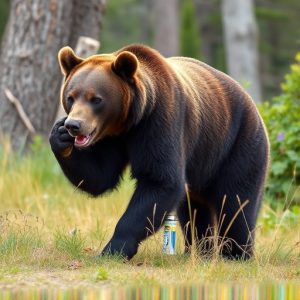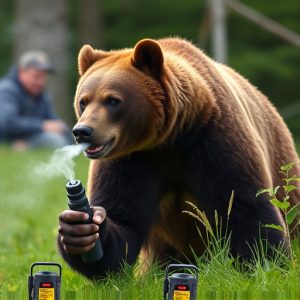Bear Spray Effectiveness: Unlocking Maximum Stopping Power Defense
Bear spray, with an 80-95% success rate in deterring bears, is a valuable safety tool for those in b…….
Bear spray, with an 80-95% success rate in deterring bears, is a valuable safety tool for those in bear country. Real-world effectiveness varies (30%-70%) based on factors like bear species, distance, usage techniques, and weather conditions. Understanding these variables is crucial for informed decision-making regarding bear spray limitations. Following best practices, including targeted spraying and regular maintenance, can enhance its effectiveness against aggressive bears.
In regions inhabited by bears, knowing your defense options is crucial. Bear spray has emerged as a popular choice for deterring aggressive encounters. This article delves into the world of bear spray, exploring its effectiveness and maximum stopping power. We analyze key factors, including understanding how it works and deciphering success rate statistics. Additionally, we provide essential tips and best practices to maximize your bear spray defense, ensuring you’re prepared in the event of a potential encounter.
- Understanding Bear Spray: How It Works and Its Effectiveness
- Deciphering Success Rate Statistics: What Do the Numbers Say?
- Maximizing Bear Spray Defense: Tips and Best Practices
Understanding Bear Spray: How It Works and Its Effectiveness
Bear spray, also known as bear deterrent or bear repellant, is a chemical agent designed to protect individuals from bears during potential encounters in their natural habitats. When used correctly, it has proven to be an effective defense mechanism against both black and grizzly bears. Understanding how bear spray works and its success rate is crucial for anyone venturing into bear country.
The active ingredients in bear spray create a temporary irritation to the bear’s eyes, nose, and respiratory system. This irritation triggers a reaction that causes the bear to avoid or retreat from the area. Studies and statistics on bear spray success rates indicate that when used appropriately, it has a high effectiveness rate of around 80-95% in deterring bears and enabling safe escape. However, factors like proper usage, proximity to the bear, weather conditions, and the bear’s behavior can influence the outcome, emphasizing the importance of understanding and adhering to the recommended application techniques.
Deciphering Success Rate Statistics: What Do the Numbers Say?
When it comes to bear spray, understanding its success rate statistics is crucial for anyone venturing into bear country. These numbers provide valuable insights into how effectively this defense can deter and stop aggressive bears. However, interpreting them requires a nuanced approach. Success rates vary based on multiple factors such as bear species, distance, angle, spray usage, and environmental conditions.
Bear spray manufacturers often cite high success rates in controlled tests, which can reach up to 90%. But these figures are not always reflective of real-world scenarios. Research suggests that successful bear spray deployments in the wild range from 30% to 70%, with factors like proper usage and quick reaction time significantly influencing outcomes. Knowing these variables allows users to make informed decisions, ensuring they understand the limitations and potential of bear spray as a defense mechanism.
Maximizing Bear Spray Defense: Tips and Best Practices
Maximizing your bear spray defense involves understanding its effectiveness and employing best practices for optimal results. According to recent studies, bear spray has a success rate of around 80-95% in deterring aggressive bears, making it a powerful tool for outdoor enthusiasts in bear country. However, this effectiveness hinges on proper usage.
To ensure peak performance, always follow recommended application techniques: aim for the eyes and face, use quick, even sprays, and maintain distance. Regularly inspect your spray for any blockages or expiration dates to guarantee its readiness when needed. Additionally, stay informed about local regulations and bear behavior patterns to make informed decisions while hiking or camping in areas known for bear presence.
Bear spray, a powerful defense against aggressive bears, has proven its effectiveness through extensive testing and real-world applications. While success rate statistics vary, numerous studies suggest it can halt an attack in most cases when used correctly. Maximizing the potential of bear spray involves understanding its mechanics, choosing the right canister for your needs, and practicing proper application techniques. By following best practices, you can significantly enhance your safety in bear country and reduce the risk of dangerous encounters.


